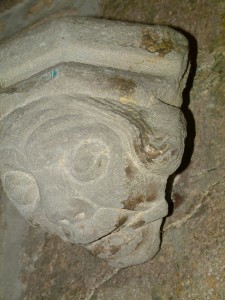St Mary’s Chapel has a large number of carved stone corbels, some of which will be featured in future posts. However, the one shown here is something of an enigma, because it is hung on the wall and is not part of the structure of the building. Where it was originally is not known.
In years gone by there was an offence, called in Latin communis rixatrix. Those words are in the feminine gender, so it was something that only women could commit. The ‘crime’ was to be a troublesome and angry female, who broke the public peace by habitually arguing and quarrelling. The common phrase was a ‘common scold’. The punishment was to put a bridle on the woman’s head, which included a bit, or something equivalent, in her mouth to press down on the tongue. Some were quite horrendous with sharp spikes on the bit. In Scotland this contraption was often called a brank’s bridle (or simply branks), with the first recorded instance of its use in 1567. It was supposed to be a minor punishment and was often inflicted on female offenders by Kirk Sessions and barony courts. Presumably the intention of the punishment was to stop the woman from speaking, hence the other common name: ‘the gossip bridle’. Quite often, the woman concerned was paraded in public then tied to the town cross or a similar prominent place. The duration of this humiliation would be determined by the Kirk Session or barony court. One assumes that the pain, discomfort and public humiliation was intended to act as a deterrent to others. In England and Wales the actual law was abolished as recently as 1967. It should also be noted that there are records of the branks being used on men – so in reality it was not just for women!

In the photograph the bridle going through the mouth can be clearly seen. So what is a carved head such as this doing in a church? We just do not know! It seems unlikely that it was intended to be part of the building in the same way as the other corbels. Perhaps a previous Kirk Session had decided that this carving should be made and displayed to the congregation as a warning! Any (sensible) suggestions would be welcome!